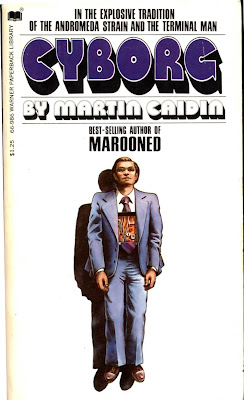Saturday, July 17, 2021
Book Review: Planet Run
Thursday, July 15, 2021
At the library sale, July 2021
Monday, July 12, 2021
Book Review: Cyborg
'Cyborg' first was published in April 1972 by Arbor House; this paperback edition (318 pp.) was issued by Warner Paperback Library in December 1972 (the cover artist is uncredited).
Both hardbound and paperback copies of 'Cyborg' have Bookjackers demanding steep prices at amazon and eBay. I was able to find a somewhat battered copy of the book at McKay's in Manassas for 65 cents.
'Cyborg' became the basis for the TV series The Six Million Dollar Man, which initially aired on ABC in 1973 as three episodes. Viewership was sufficiently high for the network to order five full seasons over 1974 - 1978. Capitalizing on the success of the TV show, Caidin wrote two more Steve Austin novels, 'High Crystal' (1974) and 'Cyborg IV' (1975).
A gallery of the various editions of Caidin's 'Cyborg' novels, including some impressive paintings by UK artist Richard Clifton-Dey, is available at the Dead Man's Brain blog.
'Cyborg' is set in the mid-70s and as it opens, 32 year-old Steve Austin, NASA's youngest astronaut and one of its best test pilots, is conducting a trial flight of the M2-F2 lifting body aircraft. Coming in for a landing, the aircraft goes out of control and crashes on the runway (footage of the actual crash of the M2-F2 on May 10, 1967, involving pilot Bruce Peterson, was used in the opening sequence of The Six Million Dollar Man).
Austin survives the crash, albeit with severe injuries. But physicians Rudy Wells and Michael Killian have a plan, one that will be funded - to the tune of 6 million dollars (a large sum by 1970s standards) - by Oscar Goldman, director of the federal government's clandestine Office of Special Operations (OSO).
Steve Austin will be the world's first Bionic Man........a cyborg whose body is a combination of the organic and inorganic. Rebuilding Austin will require the most advanced technologies yet known to man, and the path to recovery and functionality will be a long and arduous one. But if any one man can do it, it will be Steve Austin.
However, as Austin is to discover, when the OSO invests 6 million dollars in your rehabilitation, it's never done out of kindness. Oscar Goldman wants a return on his investment.........a return that involves a dangerous mission to covertly retrieve foreign technology. And what would be a suicide mission for an ordinary spy, may be entirely feasible for a bionic man............
The opening chapters of 'Cyborg' are engaging, as Caidin relates - in crisp prose - the execution of the ill-fated flight, the disastrous accident, and the desperate effort to salvage what's left of astronaut Austin.
The middle chapters see the narrative lose momentum, as Caidin belabors the psychological and emotional traumas that accompany Austin's efforts to adapt to his new existence as a bionic man. Needless to say, melodrama was not author Caidin's strong suit as a writer: the too-plentiful scenes in which Austin acts out in anger against his medical team, and wallows in self-pity, foster a contrived melodrama and (unintentionally, I'm guessing) permit the reader to readily conclude that Austin is a Prick.
Steve Austin doesn't make the transition from experimental subject to a Nick Fury Agent of S.H.I.E.L.D. 'superspy' until page 201, well into the novel. Things pick up plot-wise at this point, as Austin undertakes dangerous missions against the infrastructure of the Soviet Bloc, and the final third of the book is rewarding for those who like well-composed action sequences, particularly those featuring aeronautical derring-do, a subject with which Caidin was well acquainted.
The closing chapters then shift the emphasis to a survival scenario, one of the best such sequences I've ever read.
It's worth noting that in 'Cyborg' Steve Austin has no scruples about using his superhuman powers to kill Commies, rape-hungry Arabs, and other 1970s 'undesirables'. These episodes of violence give the novel a harder edge that The Six Million Dollar Man (which aired in Prime Time) was not permitted.
[ I should alert potential readers under 30 that Caidin's depiction of women in the pages of 'Cyborg' is very un-Woke; however, those over 30 likely will be entertained by the chauvanistic sensibility that permeates the novel. ]
The verdict ? While I can't recommend that you spend considerable money to acquire a copy of 'Cyborg', if you can find it for a reasonable price, it's worth picking up. Overall, its melding of sci-fi and action works well and retains that distinctive Old School, Macho-Man flavor that nowadays is fast fading into distant memory.
Friday, July 9, 2021
The Fabulous Furry Freak Brothers and the Mysterious Visitor
by Gilbert Shelton and Dave Sheridan
from Thoroughly Ripped with the Fabulous Furry Freak Brothers (Rip Off Press, 1978)
Tuesday, July 6, 2021
Junk food from Ollie's
Ollie's Bargain Outlet is a chain of discount stores that started in central Pennsylvania in the 1980s, and now has stores in 25 states. They usually lease their stores in formerly prosperous shopping centers........what may have been a thriving PetCo, or Kmart, or Joann Fabrics in 2003, is now an Ollie's.
Some of the parking lots where Ollie's are located require concentration and care to negotiate......I recently was at the Frederick, Maryland store (second from top, above) and while inside, a severe thunderstorm swept into the area. The rain was pounding on the store roof so hard I couldn't hear the music playing on the speaker system. When I had waited out the worst of the rain by standing under the storefront, I discovered that the parking lot had flooded, and I had to wade through ankle-deep water to my car.........
I periodically visit Ollie's for sundries. The chain advertises itself as 'Good stuff - cheap !' and that's true. Ollie's buys truckloads of surplus inventory and sells it at discounted prices, exclusively in its brick-and-mortar stores (the chain has no online sales portal). According to a 2019 article in Forbes, Ollie's is thriving at a time when many brick-and-mortar stores are not doing well.
According to Forbes, Ollies customers '.....tend to be lower-middle class or poorer.......' Whether I qualify for this designation is open to contemplation, but I do find Ollie's a source for cheap junk food. Some brands that aren't available in other stores can be found at Ollie's; for example, while Mallow Cups from Boyer were plentiful in my youth during the 70s, I haven't seen them anywhere in the past 20 (30 ?!) years, but I found big packs of them at Ollies.
Some of the items available at Ollie's represent flavors that didn't survive the brutal competition on the shelves of major grocery stores. In that regard, perhaps it's for the best that 'S'mores' flavored snack balls, 'Orange Cream Pop' snack balls, and 'Dippin' Dots' snack balls have been expunged from the retail environment.And let's be fair. If a bag of chips is priced at $1.89, or a box of 16 exotically flavored Pop Tarts is only $2.59, you're not spending a whole lot of money to investigate, are you ?
Saturday, July 3, 2021
Book Review: Thieves' World
Thursday, July 1, 2021
My Sweet Summer Suite
by Barry White and the Love Unlimited Orchestra
Monday, June 28, 2021
Book Review: Earthblood and Other Stories
Saturday, June 26, 2021
Robo Hunter: Verdus
The 'Verdus' storyline of 'Robo-Hunter' initially appeared in 2000 AD from prog 76 (August 5, 1978) to Prog 112 (May 12, 1979) with scripting by John Wagner and illustrations by Ian Gibson (with the initial issues handled by Jose-Luis Ferrer).
This 136 - page compilation of the complete 'Verdus' comics was issued by DC in 2004, part of a rather short-lived partnership with the UK's Rebellion publishing house to issue reprints of selected 2000 AD titles for the American comics market.
'Robo-Hunter: Verdus' has the dimensions (7 1/ 2 x 10 1/4 inches) of the American graphic novel, which means it was reduced from the UK format (9 inches wide x 11 inches).
Wednesday, June 23, 2021
The ruins of New York City from Planet of the Apes magazine No. 7
by Alfredo Alcala













































.jpg)

















